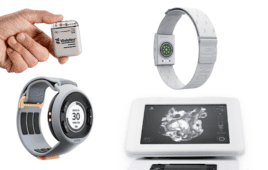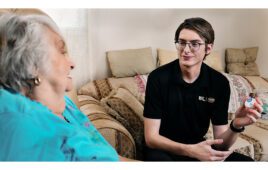Smith & Nephew Orthopaedics, a global provider of trauma and joint replacement systems for knees, hips, and shoulders, has begun to sterilize devices in-house. This exclusive report examines how the company approached the selection of a sterilization method, the cycle development, and the validation process.
|
|
AT A GLANCE
• Defining 4 main processes
• Guidance from FDA
• Pareto analysis results
• Validation in 3 steps
David B. Vogel is the director of validation and microbiological control at Smith & NephewInc., 1450 Brooks Rd., Memphis, TN 38116. He has been involved with the sterilizationof medical devices for more than 15 years and has directed the development andvalidation of ethylene oxide, steam, gamma, gas plasma, and VHP sterilizationprocesses for various medical devices during his career. Vogel can be reachedat 901-399-6234 or dave.vogel@smith-nephew.com. In addition, information aboutSTERIS Corp. can be obtained by calling 440-392-7659.
By David B. Vogel
In a recent move to dramatically reduce manufacturing turnaround time and increaseresponsiveness, Smith & Nephew Orthopaedics, a global provider of trauma and joint replacement systems for knees, hips, and shoulders, has begun sterilizing some of the orthopedic devices it produces in-house rather than outsourcing this service. The selection of a sterilization method, the cycle development, and the process validation performed by the company’s microbiology and research teams provide a practical case study for manufacturers contemplating upgrading or bringing their own sterilization processes in-house.
Why Sterilize In-House?
Smith & Nephew’s manufacturing process uses Just-in-Time and lean manufacturing methods. Being able to sterilize product as it is manufactured provides flexibility in product scheduling and enables a rapid response to changes in customer demands.
Previously, the company’s sterilization process was outsourced to an ethylene oxide (EtO) facility located near its orthopedics manufacturing division in Memphis. The EtO process, unfortunately, has a very long turnaround time. From start to finish, this typically resulted in a 12-day period before product could be placed into stock. Because of the relatively small product volumes, accumulating sufficient product to fill the large 12-pallet EtO chamber contributed to the delay. The sterilization cost per unit jumps dramatically if partial loads are run, and outsourcing to more distant EtO services with smaller chambers would have added transportation costs and delays. Smith & Nephew saw a clear manufacturing advantage in moving to in-house sterilization.
Process Selection
Once the decision was made to bring sterilization on site, Smith & Nephew investigated several sterilization methods for in-house use. Among the methods considered were EtO, pulsed white light, gas/plasma, and vaporous hydrogen peroxide (VHP) sterilization.
Ethylene Oxide
EtO works by vaporizing the ethylene oxide in a sterilization chamber. Sterilized pieces are then transferred to an aeration cell, where they remain until the gas disperses and the pieces are safe to handle. Vaporized EtO is toxic to surface contaminants.
Despite its excellent materials compatibility with joint replacement materials, EtO was not suitable for Smith & Nephew’s in-house use. The product volume could not justify the high cost of setting up sterilization chambers, monitoring the process, and managing the environmental issues. Also, hazardous materials training, protective attire, and risk management, as well as EtO recovery and regulatory paperwork, would have added to annual operating costs.
Pulsed White Light
|
|
This method involves a high-voltage discharge to a lamp. It generates a pulse that delivers up to 6 joules per square centimeter of broadband white light (with about 25 percent in the UV range) lasting only a few milliseconds. Photochemical mechanisms inactivate any microorganism. Because exposure is so brief, very little heat builds up in the product.
In addition to the difficulty posed by opaque objects with complex surfaces that can cause shadowing, this method would have required major packaging changes to ensure sterilization of the implants. The cost of changing the packaging for all product lines ruled out this approach.
Gas Plasma
Gas plasma technology uses radio-frequency (RF) energy to convert hydrogen peroxide vapor to a plasma state. Free radicals disrupt and destroy microbial life and then recombine to form non-toxic byproducts—primarily oxygen and water vapor.
The relatively new gas-plasma processes promised to be both effective and compatible with the company’s manufacturing environment. However, three factors proved troublesome. The chamber size was too small to handle product volumes. The cost per cycle was higher when compared to other new sterilization methods. Finally, given the lack of in-house experience with sterilization, the plasma phase of the process would have added complications. And because the plasma process was so new, there was little experience available to tap in the broader medical device and pharmaceutical fields.
Vaporous Hydrogen Peroxide
The VHP process employs hydrogen peroxide vapor to destroy microbes. The vapor itself provides thorough, effectual sterilization without the use of a plasma. As with gas plasma technology, it allows free radicals to disrupt and destroy microbial life and then recombine to form non-toxic byproducts.
A thorough study of available sterilization methods showed VHP sterilization to be the best fit for the company’s needs for a variety of reasons. The VHP process from STERIS Corp., a provider of medical sterilization technologies in Mentor, OH, has a long track record in sterilization for pharmaceutical aseptic production. Its low operating temperature (86°F) makes it suitable for temperature-sensitive orthopedic implant materials; and because it decomposes into water vapor and oxygen, VHP is environmentally friendly with no toxic residues or carcinogenic byproducts.
With sterilization cycles under three hours—including aeration—VHP offers rapid turnaround times. Reduced incubation studies (following “The FDA Guide for Validation of Biological Indicator Incubation Time,” Center for Devices and Radiological Health) showed that release could be achieved 48 hours after sterilization.
Additionally, the VHP process has the potential to be certified for parametric release, eliminating the two-day biological indicator (BI) growth phase. Parametric release is defined as “the declaration of adequacy of routine processing for validated sterilization process based solely on measurement and documentation of physical parameters rather than results of biological indicator or product sterility evaluation” (AAMI TIR20:2001, “Parametric Release for Ethylene Oxide Sterilization.”)
Other important factors in the decision were the variety of chamber sizes, the option for a double-door unit that allows direct coupling of the sterilizer to the existing clean room, and the user-friendly VHP sterilizer operation. Finally, the operational cost was comparable to EtO sterilization cost per cubic foot.
Supplier support was another consideration in choosing VHP. With no in-house experience in maintaining or servicing sterilization equipment, Smith & Nephew needed a company that could supply maintenance while in-house technicians were learning the process. STERIS offered on-site maintenance service for the sterilizer through a comprehensive support plan. The final factor in the decision was STERIS’ strong technical support team for sterilization issues.
Process Development
Although the VHP process had a history of use in the pharmaceutical industry, the experience of companies that had used the VHP vacuum sterilization method was not publicly available. Smith & Nephew initiated a rigorous program of process development and qualification testing in order to understand the VHP process thoroughly before moving into production.
Before beginning the testing, the regulatory affairs and microbiology groups consulted the FDA for guidance on the FDA review process. Based on the agency’s recommendation, the scientists developed a testing and validation plan using ANSI/AAMI/ISO 14937:2000, “Sterilization of Health Care Products—General requirements for characterization of a sterilizing agent and the development, validation, and routine control of a sterilization process for medical devices.”
|
|
The first priority was demonstrating that the BI recommended for the atmospheric VHP process was also the most resistant for the vacuum process that Smith & Nephew would be using. Studies compared the resistance of various BIs to the VHP process in order to select the most rigorous standard. A comparison of Bacillus pumilus, Bacillus atrophaeus, and Geobacillus stearothermophilus in the VHP MD 2000 showed that G. stearothermophilus is the most resistant BI to the VHP process. Thus, in further testing, G. stearothermophilus was used to demonstrate the effectiveness of the sterilization process.
The sterilization cycle for the specific application was developed under the guidelines of ANSI/AAMI/ISO 14937:2000. Cycle development was based on the overkill approach, using the challenge of the resistant BI rather than the inactivation of the product bioburden. The researchers performed BI inactivation studies in the VHP sterilizer to generate two sets of data: direct enumeration, which provides data on how the process affects the resistant BI in the upper range of the inactivation curve, and fraction negative data, which determines the inactivation of the BI where a low probability of survivors occurs. When used together, these methods provide the necessary understanding of the inactivation kinetics so that the probability of a surviving microorganism can be calculated. Using this approach, process developers established the length of the cycle for a specified gas concentration and temperature. The profile of the developed cycle is shown in Figure 1.
The sterilization phase consists of a series of pulses. Each pulse can be described as a sequence of sub-phases consisting of the evacuation phase, the H2O2 injection phase, the H2O2 hold phase, and the transition phase. The absolute pressure setpoint used for the deep vacuum evacuation is programmable but is typically 1.0 Torr (1.3 mbar). This ensures that the vast majority of the air has been removed prior to the injection of the H2O2.
Once the cycle was established, material compatibility issues had to be ruled out. In addition, further studies were conducted to define the critical process parameters.
Materials Compatibility
Smith & Nephew performed extensive in-house materials compatibility testing to ensure that VHP sterilization would cause no degradation in joint replacement or packaging materials. These tests included the effects of aging, static mechanical properties determined by uniaxial tension testing, toughness using Izod double notch impact testing, shore hardness, the oxidation index using Fourier transform infrared spectroscopy (FTIR), density, melt temperature, and percent crystallinity based on thermal analysis.
Results showed that sterilization with VHP does not change the mechanical properties of ultra high molecular weight polyethylene (UHMWPE) as illustrated in Figures 2 and 3. Smith & Nephew verified that the new process performs as well as the previous EtO process. As a control for oxidation, product that was sterilized with gamma radiation in an air atmosphere showed significant oxidation as seen in Figure 2.
Critical Process Parameters
|
|
To determine which manufacturing process variables are most critical for controlling the sterilant concentration in the sterilization chamber, researchers developed a design of experiment (DOE) using Statgraphics Plus 4.0 software by Manugistics Inc., Rockville, MD. In a randomized study using a two-level factorial model, five process variables were investigated for product packaged in glycolized polyester (PETG) trays: product temperature, chamber temperature, load volume, transition gas, and sterilant weight. The study consisted of 32 test cycles performed in duplicate.
An analysis of variance (ANOVA) was performed on the process data. The resulting Pareto chart (Figure 4) illustrates the relative importance of process variables on sterilization efficacy. The vertical dashed line indicates the critical t-value at the 0.05 significance level. Effects that fall below this line are not considered significant. Pairs of letters represent the interaction between two process variables.
The Pareto analysis revealed useful information about which process variables need to be carefully controlled. This information is detailed in the five points below.
1. Load volume is by far the biggest factor—twice as important as the next most important factor—due to absorption of the sterilant. It was later demonstrated that the product does not absorb hydrogen peroxide. Thus, the primary absorbent material is the PETG tray.
2. Sterilant weight was shown to be critical, but this was expected. The more sterilant injected, the higher the concentration of sterilant in the chamber.
3. Chamber temperature, which reflects the potential for condensation on chamber walls and thus reduction in peroxide vapor concentration, is fairly significant.
4. While product temperature is a factor, it is less significant than chamber temperature. This was an important finding because product is loaded directly into the chamber from the clean room, which is typically 22°C. Thus, it is not critical to raise the product temperature to the chamber temperature (30°C) before processing.
5. Transition gas is actually a measure of chamber humidity. When process air was compared with dry nitrogen, no significant difference was observed.
Process Validation
Process validation was performed in three phases as depicted in Figure 5.
The “Installation Qualification” phase verified that the received unit met the design specifications.
The “Operational Qualification” phase confirmed that the unit (software, alarms, etc.) was operating correctly. Temperature profiles were conducted on the chamber walls, the chamber air, and the product during a sterilization cycle in order to document how temperatures varied during the cycle. This information proved useful later when a BI failure occurred. The cause was traced back to a change in the chamber wall temperature that occurred when the jacket circulation pump failed.
Successful sterilization requires that the product achieve the acceptable sterility assurance level (SAL) of 10-6, the international standard for sterile product. The “Performance Qualification” phase tested the limits of the process under reduced process cycles (1/2 cycles), reduced VHP sterilant concentration, higher and lower chamber temperatures, and both minimum and maximum product loads to demonstrate that the maximum and minimum parameters did not impact the sterilization efficacy. Finally, the full process cycle was applied to packaged product to verify that no peroxide residuals remained and that the sterilization process did not compromise package seal integrity.
This extensive evaluation established a thorough understanding and high confidence level in the VHP sterilization process and demonstrated that the product is sterilized to the required SAL under all process conditions.
Looking Into the Future
|
|
Currently, Smith & Nephew is using the in-house VHP process for UHMWPE liners for hip replacements. The sterilization technology has been integrated into the manufacturing process and plans are now underway to purchase a second unit to expand its use for plastics used in knee products.
The company is also progressing toward the goal of obtaining certification for parametric release. Future studies of the technology are scheduled to determine how the critical process parameters must be controlled. Working with STERIS, Smith & Nephew has developed a software program that records all critical process data including sterilant concentration. Studies have been planned to evaluate the recorded data and verify that the software will identify and flag a process failure.
By proceeding methodically, testing definitively, and committing to developing a full understanding of the process, Smith & Nephew has successfully managed innovation in its sterilization processing that meets the goals of reducing manufacturing turnaround time and increasing customer responsiveness.
ONLINE
For additional information on the technologies discussed in this article, see Medical Design Technology online at www.mdtmag.com and the following websites:
• www.smith-nephew.com
• www.steris.com
• www.statgraphics.com









